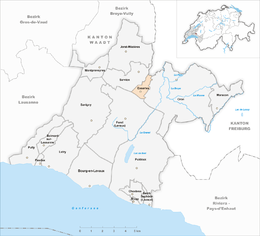Essertes
| Essertes | ||
|---|---|---|
|
||
| Coordinates: 46°34′N 06°47′E / 46.567°N 6.783°ECoordinates: 46°34′N 06°47′E / 46.567°N 6.783°E | ||
| Country | Switzerland | |
| Canton | Vaud | |
| District | Lavaux-Oron | |
| Government | ||
| • Mayor |
Syndic Philippe Bardet |
|
| Area | ||
| • Total | 1.65 km2 (0.64 sq mi) | |
| Elevation | 737 m (2,418 ft) | |
| Population (Dec 2015) | ||
| • Total | 330 | |
| • Density | 200/km2 (520/sq mi) | |
| Demonym(s) | Les Coucous | |
| Postal code | 1078 | |
| SFOS number | 5788 | |
| Surrounded by | Auboranges (FR), Vuibroye, Châtillens, Forel (Lavaux), Servion | |
| Website |
www Profile (French), SFSO statistics |
|
Essertes is a municipality in the district of Lavaux-Oron in the canton of Vaud in Switzerland.
Essertes is first mentioned in 1154 as terram de Sartis. In 1271 it was mentioned as de Essertes.
Essertes has an area, as of 2009[update], of 1.7 square kilometers (0.66 sq mi). Of this area, 1.23 km2 (0.47 sq mi) or 74.5% is used for agricultural purposes, while 0.28 km2 (0.11 sq mi) or 17.0% is forested. Of the rest of the land, 0.15 km2 (37 acres) or 9.1% is settled (buildings or roads).
Of the built up area, housing and buildings made up 4.8% and transportation infrastructure made up 4.2%. Out of the forested land, 10.9% of the total land area is heavily forested and 6.1% is covered with orchards or small clusters of trees. Of the agricultural land, 58.2% is used for growing crops and 13.9% is pastures, while 2.4% is used for orchards or vine crops.
The municipality was part of the Oron District until it was dissolved on 31 August 2006, and Essertes became part of the new district of Lavaux-Oron.
The municipality is located in the Jorat region, on the border with the Canton of Fribourg. It consists of the linear village of Essertes (on the Vevey-Moudon road) and the hamlets of Bretonnaire and Les Clos.
The blazon of the municipal coat of arms is Gules, on a Stump eradicated Or a Cuckoo proper.
Essertes has a population (as of December 2015[update]) of 330. As of 2008[update], 15.6% of the population are resident foreign nationals. Over the last 10 years (1999–2009 ) the population has changed at a rate of 10.1%. It has changed at a rate of 2.4% due to migration and at a rate of 7.3% due to births and deaths.
...
Wikipedia




